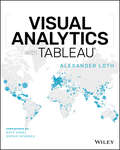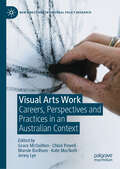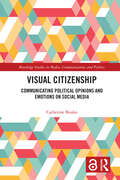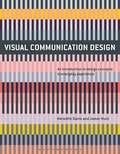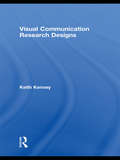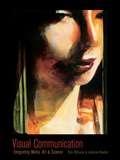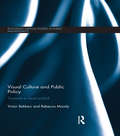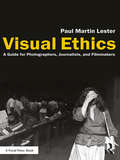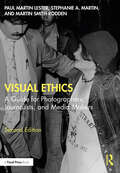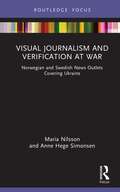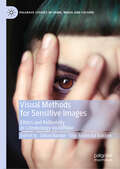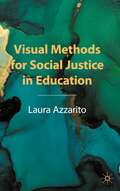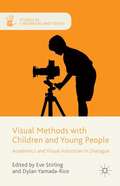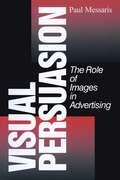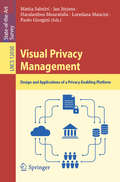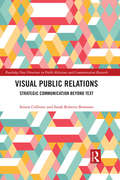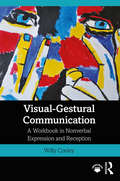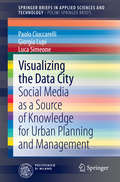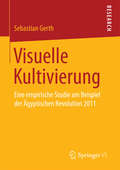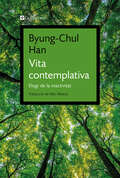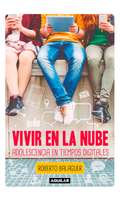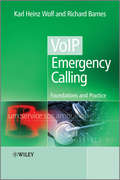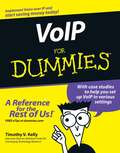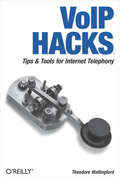- Table View
- List View
Visual Analytics with Tableau
by Alexander LothA four-color journey through a complete Tableau visualization Tableau is a popular data visualization tool that’s easy for individual desktop use as well as enterprise. Used by financial analysts, marketers, statisticians, business and sales leadership, and many other job roles to present data visually for easy understanding, it’s no surprise that Tableau is an essential tool in our data-driven economy. Visual Analytics with Tableau is a complete journey in Tableau visualization for a non-technical business user. You can start from zero, connect your first data, and get right into creating and publishing awesome visualizations and insightful dashboards. • Learn the different types of charts you can create • Use aggregation, calculated fields, and parameters • Create insightful maps • Share interactive dashboards Geared toward beginners looking to get their feet wet with Tableau, this book makes it easy and approachable to get started right away.
Visual Arts Work: Careers, Perspectives and Practices in an Australian Context (New Directions in Cultural Policy Research)
by Marnie Badham Kate MacNeill Grace McQuilten Chloë Powell Jenny LyeThis book provides the most comprehensive picture to date of work in the visual arts ecosystem in Australia. In a context where artists’ incomes are consistently low and falling, commercial galleries are financially vulnerable, and public galleries face program funding challenges — this book explores barriers to the economic health of the sector, the challenge of improving artists’ and arts workers’ working conditions, and the realities of being a creative in the twenty-first century. The book combines an analysis of art world economic value chains alongside alternative and emergent cultural, social and political economies with new quantitative and qualitative insights from artists and arts workers. With interdisciplinary methodologies and industry engagement, it examines multiple and hybrid systems of value and includes the perspectives of visual artists, craft artists and arts workers with diverse lived experiences. Our research offers greater insight into the social, cultural, and political forces that underly the mediation of art to the public including an urgent emphasis on gender, cultural safety and care work including the concerns of First Nations artists, culturally and linguistic diverse artists, and artists with disability. Our approach unpacks the diversity and hybridity of art ‘work’ to include practices realised through digitisation, internationalisation, community engagement and intersectoral partnerships.
Visual Citizenship: Communicating political opinions and emotions on social media (Routledge Studies in Media, Communication, and Politics)
by Catherine BoukoThis book explores visual political engagement online – how citizens participate in the dynamism of life in society by expressing their opinions and emotions on various issues of democratic life in image-based social media posts, independently of collective actions.Looking beyond large digital social movements to focus on the everyday, the book provides a well-documented and comprehensive framework of key notions, concrete methods and examples of empirical insights into everyday visual citizenship on social media. It shows how the visual has become ubiquitous in citizens’ communication on social media, focusing on how citizens use visual content to express their emotions and opinions on social media platforms when they discuss politics in a large sense.With this book, every reader interested in political communication, visual communication and/or new media is fully equipped to analyse everyday visual citizenship on social media platforms.The Open Access version of this book, available at http://www.taylorfrancis.com, has been made available under a Creative Commons [Attribution-Non Commercial-No Derivatives (CC-BY-NC-ND)] 4.0 license.
Visual Communication Design: An Introduction To Design Concepts In Everyday Experience (Required Reading Range #75)
by Meredith Davis Jamer HuntThis book traces the origins of visual phenomena and principles for the arrangement of form by providing examples that encounter in going about the daily lives. The authors provide a new slant on design basics from the perspective of audiences and users. Chapters break down interactions with communication as a sequence of meaningful episodes, each with related visual concepts that shape the interpretive experience. Explanatory illustrations and professional design examples support definitions of visual concepts and discussions of context. Work spans print, screen and environmental applications from around the world.
Visual Communication Research Designs
by Keith KenneyVisual Communication Research Designs provides a step-by-step guide for designing research involving visuals relevant to communications media. This volume explains the process from conceptualization to research questions, instrumentation, analysis, and reliability and validity checks. It also addresses the lack of sufficient methods to answer theoretical questions attending visual communication. This resource has been developed in response to the circumstance in which, in many cases, the methodologies used for verbal and textual communications are inappropriate or ineffective when applied or adapted for the study of visual communications. Additionally, research articles from ethnography, action research, rhetoric, semiotics, psychology, cultural studies, and critical theory often do not use examples appropriate to visual communication readers. To address these issues, this book explains in clear and straightforward language key research designs, including new methodologies, that are appropriate for scholars and students conducting visual communication research. Organized into three parts -- production, analysis, and effects of visuals – this research text provides guidance in using, interpreting and measuring the effects of visual images. It addresses such topics as: producing photographs and video that can be used as research data; interpreting images that already exist; measuring the effects of visuals and to understand their use by different groups. Ethical issues are included, as well as a discussion of the advantages and limitations of each method. "War stories" are provided by experienced researchers, who discuss a particular research project and explain pitfalls to avoid, as well as what to do when problems occur. The primary audiences are scholars, researchers, and students conducting research on motion pictures, video, television, photographs, illustrations, graphics, typography, political cartoons, comic books, animation, and other media with a visual component. Individuals will use this text whenever they need to conduct research that involves visuals in the media. The book will be a required text for advanced courses in visual culture, seminars on visual communication research, and other research methods courses integrating a visual component.
Visual Communication: Integrating Media, Art, and Science
by Rick Williams Julianne NewtonA well-rounded education in the 21st century requires not just verbal and mathematical proficiency, but also the ability to interpret, critique, create, and use visual communication on sophisticated levels. In today’s visual world, it is critically important to hold an appreciation for the profound effects imagery has on individuals and the communities in which they live. Visual Communication focuses on cultivating visual and media literacy from both consumption and production points of view and introduces students to the application of intuitive intelligence to a visual context. Innovative in its field, it provides a solid theoretical overview of the most advanced thinking and research about visual communication, teaching readers how to apply theory to enhance their understanding of and work with images. This book is intended for students in visual literacy and communication courses. It can also be used in photojournalism courses and other coursework with a visual component. Individuals interested in mass media studies will likewise find the book to be a worthwhile read.
Visual Culture and Public Policy: Towards a visual polity? (Routledge Critical Studies in Public Management)
by Victor Bekkers Rebecca MoodyTraditionally, images have played an important role in politics and policy making, mostly in relation to propaganda and public communication. However, contemporary society is inundated with visual material due to the increasing ubiquity of media and visual technologies that facilitate the production, distribution and consumption of images in new and innovative ways. As such, a visual culture has emerged, and a number of authors have written on visual culture and the technologies which underlie it. However, a clear link to policy making is still lacking. This books links the emergence of this visual culture to policy making and explores how visual culture (and the growing number of technologies used to create and distribute images) influence the course, content and outcome of public policy making. It examines how visual culture and policy making in contemporary society are intertwined, elaborating concepts such as power, framing and storytelling. It then links this to technology, and the way this can enhance power, transparency, registration, surveillance and communication. Dealing with the entire cycle of public policy making, from agenda-setting, to policy design, decision making to evaluation, the book contains diverse international case studies including water management, risk management, live-stock diseases, minority integration, racism, freedom of speech, healthcare, disaster evaluation and terrorism.
Visual Ethics: A Guide for Photographers, Journalists, and Filmmakers
by Paul Martin LesterVisual Ethics addresses the need for critical thinking and ethical behavior among professionals responsible for visual messages in photography and photojournalism, film, and digital media. From the author of Photojournalism: An Ethical Approach, published more than 20 years ago, this book goes beyond photojournalism ethics. It discusses crucial contemporary concerns, including persuasion, stereotyping, global perspectives, graphic design decisions, multimedia production, social media, and more. Written for an ever-growing discipline, author Paul Martin Lester gives serious ethical consideration to the complex field of visual communication.
Visual Ethics: A Guide for Photographers, Journalists, and Media Makers
by Paul Martin Lester Stephanie A. Martin Martin Smith-RoddenAn indispensable guide to visual ethics, this book addresses the need for critical thinking and ethical behavior among students and professionals responsible for a variety of mass media visual messages. Written for an ever-growing discipline, authors Paul Martin Lester, Stephanie A. Martin, and Martin Rodden-Smith give serious ethical consideration to the complex field of visual communication. The book covers the definitions and uses of six philosophies, analytical methods, cultural awareness, visual reporting, documentary, citizen journalists, advertising, public relations, typography, graphic design, data visualizations, cartoons, motion pictures, television, computers and the web, augmented and virtual reality, social media, the editing process, and the need for empathy. At the end of each chapter are case studies for further analysis and interviews with thoughtful practitioners in each field of study, including Steven Heller and Nigel Holmes. This second edition has also been fully revised and updated throughout to reflect on the impact of new and emerging technologies. This book is an important resource for students of photojournalism, photography, filmmaking, media and communication, and visual communication, as well as professionals working in these fields.
Visual Ethics: A Guide for Photographers, Journalists, and Media Makers
by Paul Martin Lester Stephanie A. Martin Martin Smith-RoddenAn indispensable guide to visual ethics, this book addresses the need for critical thinking and ethical behavior among students and professionals responsible for a variety of mass media visual messages.Written for an ever-growing discipline, authors Paul Martin Lester, Stephanie A. Martin, and Martin Rodden-Smith give serious ethical consideration to the complex field of visual communication. The book covers the definitions and uses of six philosophies, analytical methods, cultural awareness, visual reporting, documentary, citizen journalists, advertising, public relations, typography, graphic design, data visualizations, cartoons, motion pictures, television, computers and the web, augmented and virtual reality, social media, the editing process, and the need for empathy. At the end of each chapter are case studies for further analysis and interviews with thoughtful practitioners in each field of study, including Steven Heller and Nigel Holmes. This second edition has also been fully revised and updated throughout to reflect on the impact of new and emerging technologies.This book is an important resource for students of photojournalism, photography, filmmaking, media and communication, and visual communication, as well as professionals working in these fields.
Visual Journalism and Verification at War: Norwegian and Swedish News Outlets Covering Ukraine (Disruptions)
by Maria Nilsson Anne Hege SimonsenConsidering the visual coverage of the war in Ukraine, this book provides critical insights into how newsrooms make use of visual materials, how visuals partake in journalistic storytelling in a modern wartime context, and how visual journalism practices affect the news media’s role as arbiter of accuracy and ethics.Based on a mixed-methods study, including analyses of selected visually driven news stories and interviews with media professionals in Norwegian and Swedish national media outlets houses, this book examines the news media’s approach to the visual coverage of the war in Ukraine following Russian invasion in 2022. The work is theoretically underpinned by ongoing boundary work within journalism, and editorial negotiations over issues such as verification, source criticism, and trust; witnessing and ways of seeing; and ethical gatekeeping in photojournalism. At a juncture of rising concerns over AI, public distrust, and propaganda, this study adds a real-time aspect to these debates and reveals challenges as well as emerging strategies in the unfolding coverage. Furthermore, the comparative Scandinavian context serves to highlight points of tension between the global and the local; between those newsrooms relying on global image brokers and those conducting their own in-house reporting.Written for researchers and advanced students of Visual Journalism and Conflict Reporting, this book is a timely intervention.
Visual Methods for Sensitive Images: Ethics and Reflexivity in Criminology On/Offline (Palgrave Studies in Crime, Media and Culture)
by Sidsel Harder Silje Anderdal BakkenThis edited book provides a toolbox for researchers and students working with sensitive images in criminological research on and offline. Across three sections on collecting, analysing and mediating sensitive visual data, the chapters cover a wide array of current examples and discussions of visual methods and ethics in contemporary, digital-life criminology. It reflects the experiences of influential and innovative scholars engaging in empirical analysis of images across various subfields within criminology, including with images that deal with crime, social problems and stigma. They emphasize the opportunity for gaining knowledge through visual analysis and include methodological discussions of how to approach such sensitive data material. Some chapters address visuals as data in mediated realities and the related methodological concerns. The book also contributes to discussing the various ethical sides to researching crime-related sensitive images, such as anonymity, consent, and access, but also relates to researcher reflexivity and protecting researchers' well-being.
Visual Methods for Social Justice in Education
by Laura AzzaritoThis book makes a case for the usefulness of visual research methods for advancing a social justice agenda in education. The author aims to provide education researchers with a wide range of qualitative visual research tools to invoke different stories, voices, embodiments, and experiences of individuals from marginalized communities; to advance emancipatory research projects; to embrace interdisciplinary knowledge-building; and to counter-narrate Western forms of knowledge, cultures, and values for the reimagining of education for social change. It draws attention to the importance of visual methods in today’s neoliberal landscape of education to speak back to mainstream research and practices, especially when research participants lack words to describe, express, and represent what it means to be impacted by oppression and marginalization.
Visual Methods with Children and Young People: Academics and Visual Industries in Dialogue (Studies in Childhood and Youth)
by Eve Stirling Dylan Yamada-RiceVisual Methods with Children and Young People.
Visual Persuasion: The Role of Images in Advertising
by Dr Paul MessarisThe pictures in television commercials, magazine advertisements and other forms of advertising often convey meanings that cannot be expressed as well, or at all, through words or music. Visual Persuasion is an exploration of the uniquely visual aspects of advertising. Because of the implicit nature of visual argumentation and the relative lack of social accountability which images enjoy in comparison with words, pictures can be used to make advertising claims that would be unacceptable if spelled out verbally. From this starting point, Paul Messaris analyzes a variety of commercial, political and social issue advertisements. He also discusses the role of images in cross-cultural advertising.
Visual Privacy Management: Design and Applications of a Privacy-Enabling Platform (Lecture Notes in Computer Science #12030)
by Haralambos Mouratidis Paolo Giorgini Mattia Salnitri Jan Jürgens Loredana ManciniPrivacy is a burden for most organizations, the more complex and wider an organization is, the harder to manage and enforce privacy is.GDPR and other regulations on privacy impose strict constraints that must be coherently enforced, considering also privacy needs of organization and their users. Furthermore, organizations should allow their users to express their privacy needs easily, even when the process that manages users' data is complex and involves multiple organizations.Many research work consider the problem using simplistic examples, with solutions proposed that never actually touch pragmatic problems of real, large organizations, with thousands of users and terabytes of personal and sensitive data.This book faces the privacy management problem targeting actual large organizations, such as public administrations, including stakeholders in the process of definition of the solution and evaluating the results with its actual integration in four large organizations. The contribution of this book is twofold: a privacy platform that can be customized and used to manage privacy in large organizations; and the process for the design of such a platform, from a state-of-the-art survey on privacy regulations, through the definition of its requirements, its design and its architecture, until the evaluation of the platform.
Visual Public Relations: Strategic Communication Beyond Text (Routledge New Directions in PR & Communication Research)
by Simon Collister Sarah Roberts-BowmanThis book brings together a broad and diverse range of new and radical approaches to public relations focussing on the increasingly vital role that visual, sensory and physical elements factors play in shaping communication. Engaging with recent developments in critical and cultural theories, it outlines how non-textual and non-representational forces play a central role in the efficacy and reception of public relations. Challenging the dominant accounts of public relations which center on the purely representational uses of text and imagery, the book critiques the suitability of accepted definitions of the field and highlights future directions for conceptualizing strategic communication within a multi-sensory environment. Drawing on the work of global researchers in public relations, visual culture and communication, design and cultural theory, it brings a welcome inter-disciplinary approach which pushes the boundaries of public relations scholarship in a global cultural context. This exciting analysis will be of great interest to public relations scholars, advanced students of strategic communication, as well as communication researchers from cultural, media and critical studies exploring PR as a socio-cultural phenomenon.
Visual-Gestural Communication: A Workbook in Nonverbal Expression and Reception
by Willy ConleyVisual-Gestural Communication is a truly unique volume in non-language communication devoted to the study of universal gestures, facial expressions, body language, and pantomime. Readers develop the skill and confidence to interact -- sans shared language -- with individuals, such as someone who is deaf or hard of hearing, or who speaks a foreign language. The text and accompanying online resources feature a wealth of icebreakers, sequenced yet modular activities and assignments, as well as resources, student exercises, and teacher-guided tasks that explore aspects and amalgamations of nonverbal communication, theatre, and sign language. It is a tremendous resource for students of visual-gestural communication, sign language interpretation, American Sign Language (and other foreign sign languages), nonverbal communication, theatre, and performance studies, as well as community educators in deaf awareness and advocacy. In addition to the text's vital use in the theatrical arena, it is also applicable to teachers who wish to help their students maximize the use of their facial expressions, gestures, and body language as a prerequisite to learning ASL.
Visualizing the Data City
by Giorgia Lupi Paolo Ciuccarelli Luca SimeoneThis book investigates novel methods and technologies for the collection, analysis and representation of real-time user-generated data at the urban scale in order to explore potential scenarios for more participatory design, planning and management processes. For this purpose, the authors present a set of experiments conducted in collaboration with urban stakeholders at various levels (including citizens, city administrators, urban planners, local industries and NGOs) in Milan and New York in 2012. It is examined whether geo-tagged and user-generated content can be of value in the creation of meaningful, real-time indicators of urban quality, as it is perceived and communicated by the citizens. The meanings that people attach to places are also explored to discover what such an urban semantic layer looks like and how it unfolds over time. As a conclusion, recommendations are proposed for the exploitation of user-generated content in order to answer hitherto unsolved urban questions. Readers will find in this book a fascinating exploration of techniques for mining the social web that can be applied to procure user-generated content as a means of investigating urban dynamics.
Visuelle Kultivierung: Eine empirische Studie am Beispiel der Ägyptischen Revolution 2011
by Sebastian GerthSebastian Gerth entwickelt den Ansatz der Visuellen Kultivierung, welcher die bildliche Komponente der klassischen Kultivierung schärft und mit dem Konzept von Mental Imagery verbindet. Analysiert wird der Einfluss der Online-Bildberichterstattung auf das Bildgedächtnis und die Beurteilung der sozialen Realität. Die Studie ergibt sich v.a. aus der wachsenden Bedeutung von Online-Nachrichtenportalen, der zunehmenden medialen Visualisierung, der Überlegenheit der kognitiven Verarbeitung von Bildern im Vergleich zu verbalen Botschaften und aus Desideraten der empirischen Analyse von Systematiken pressefotografischer Aussagen sowie deren Rezeption und Wirkung.
Vita contemplativa: Elogi de la inactivitat
by Byung-Chul HanUna poderosa crida a abandonar la vida hiperactiva per recuperar l'equilibri i la riquesa interior. Estem perdent la nostra capacitat de no fer res. La nostra existència és absorbida per l'activitat i, per tant, completament explotada. Atès que només percebem la vida en termes de rendiment, tendim a entendre la inactivitat com un dèficit, una negació o una absència d'activitat quan es tracta, ben al contrari, d'una interessant capacitat independent. Byung-Chul Han indaga en els beneficis, l'esplendor i la màgia de l'ociositat i dissenya una nova forma de vida que inclogui moments contemplatius amb els quals poder afrontar la crisi actual de la nostra societat i frenar la nostra pròpia explotació i la destrucció de la naturalesa.
Vivir en la nube: Adolescencia en tiempos digitales
by Roberto BalaguerRoberto Balaguer nos presenta de manera clara y concisa las problemáticas que surgen en el convulsionado mundo de internet. Ya hemos aceptado que la tecnología está cambiando al mundo de forma acelerada. Como padres, como docentes, e incluso como usuarios, intentamos enfrentar nuestros temores y acompañar a aquellos para quienes somos un referente. Sin embargo, no siempre lo logramos. A través de las páginas de este libro, Roberto Balaguer nos presenta de manera clara y concisa las problemáticas que surgen en este mundo. Además de darnos herramientas para comprender como pararnos en este escenario, nos invita a cuestionar nuestras respuestas políticamente correctas y a reflexionar sobre nuestras decisiones de la vida cotidiana. Cuando la sociedad se conmovió por la aparición del juego en línea llamado Ballena azul, el autor nos planteaba: Inmersos en una cultura de saturación de información, de alta tecnología, es frecuente que ante todos estos cambios busquemos hacer frente a los desafíos que tenemos como padres con más tecnología, pero lo cierto es que eso no siempre funciona. En toda esta temática hay tres palabras, que casualmente empiezan de la misma manera, «con», y que ilustran distintos modos de abordar estas cuestiones: control, confianza, contención.
VoIP Emergency Calling
by Richard Barnes Karl Heinz WolfThis book provides a comprehensive view of the emerging standards for VoIP emergency calling from an International perspectiveIn this book, the authors provide a treatment of the VoIP emergency calling process that is both comprehensive, looking at all aspects of emergency calling, and practical, providing technical details on how such functions can be implemented. In addition, the authors describe the standardization efforts of the Internet Engineering Task Force who are currently working to improve the situation for VoIP emergency calls. The book provides an overview of emergency calling with a particular focus on the ECRIT emergency calling architecture, and discusses considerations related to implementation, deployment, and regulation of next-generation emergency calling. It also takes a look at practical aspects of emergency calling, with a set of exercises to help the reader get familiar with the technologies involved.Key Features:Comprehensive view of emerging standards for VoIP emergency calling from an international perspectivePractical guides for implementing the core of the emergency calling architectureArchitectural, practical, and regulatory perspectivesWritten by experts working on the development of emergency calling architectures and its implementationIncludes an accompanying website with open-source software packages (http://www.voip-sos.net/)This book will be an invaluable resource for product managers and developers, equipment vendors, network operators, emergency service providers, and telecommunications regulators. Industry professionals interested in standards compliance will also find this book of interest.
VoIP For Dummies
by Timothy V. KellyPut your phone system on your computer network and see the savingsSee how to get started with VoIP, how it works, and why it saves you moneyVoIP is techspeak for "voice over Internet protocol," but it could spell "saving big bucks" for your business! Here's where to get the scoop in plain English. Find out how VoIP can save you money, how voice communication travels online, and how to choose the best way to integrate your phone system with your network at home or at the office.Discover how to:Use VoIP for your business or home phone serviceChoose the best network typeSet up VoIP on a wireless networkUnderstand transports and servicesDemonstrate VoIP's advantages to management
VoIP Hacks: Tips & Tools for Internet Telephony
by Theodore WallingfordVoice over Internet Protocol (VoIP) is gaining a lot of attention these days, as more companies and individuals switch from standard telephone service to phone service via the Internet. The reason is simple: A single network to carry voice and data is easier to scale, maintain, and administer. As an added bonus, it's also cheaper, because VoIP is free of the endless government regulations and tariffs imposed upon phone companies.VoIP is simply overflowing with hack potential, and VoIP Hacks is the practical guide from O'Reilly that presents these possibilities to you. It provides dozens of hands-on projects for building a VoIP network, showing you how to tweak and customize a multitude of exciting things to get the job done. Along the way, you'll also learn which standards and practices work best for your particular environment. Among the quick and clever solutions showcased in the book are those for:gauging VoIP readiness on an enterprise networkusing SIP, H.323, and other signaling specificationsproviding low-layer security in a VoIP environmentemploying IP hardphones, analog telephone adapters, and softPBX serversdealing with and avoiding the most common VoIP deployment mistakesIn reality, VoIP Hacks contains only a small subset of VoIP knowledge-enough to serve as an introduction to the world of VoIP and teach you how to use it to save money, be more productive, or just impress your friends. If you love to tinker and optimize, this is the one technology, and the one book, you must investigate.
